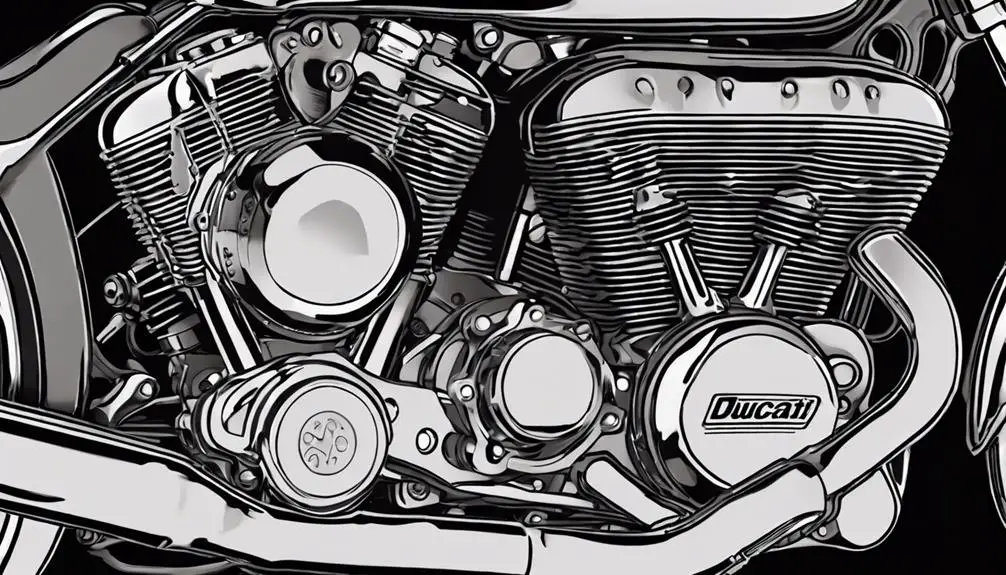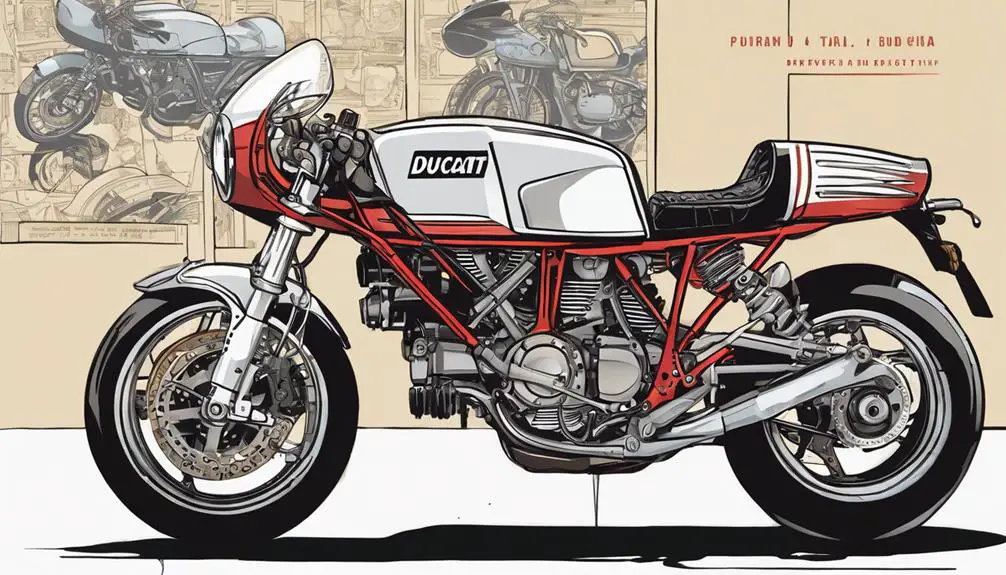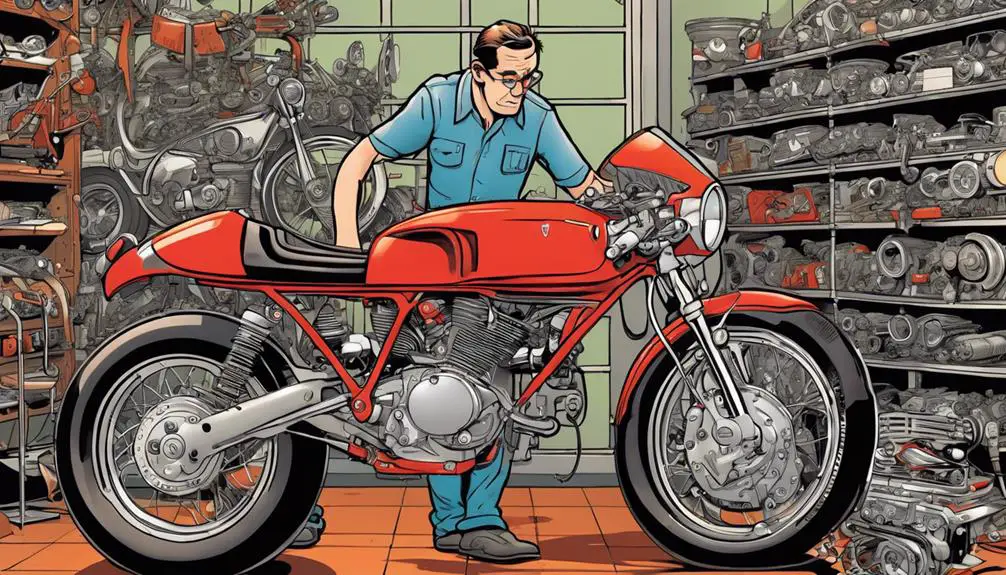When you're trying to identify classic Ducati models, it's crucial to focus on several key elements that differentiate these iconic bikes. Start by examining the frame number, as it holds critical information about the production year and specific model. You'll also want to analyze engine specifications and look for unique design features that define Ducati's legacy. But that's just the beginning—there's much more to uncover about evaluating originality and understanding model variants. Curious about the nuances that can make or break your identification process? Let's explore this further.
Key Takeaways
- Examine the frame number for model and production year insights, ensuring authenticity and lineage understanding.
- Analyze engine specifications, including displacement and configuration, to assess performance characteristics.
- Identify unique design features like the trellis frame and desmodromic valvetrain that define Ducati's engineering style.
- Assess originality by checking for matching numbers and original components, enhancing historical value.
Research Ducati History

To truly understand Ducati models, you should explore the brand's rich history, which reveals the evolution of its iconic motorcycles. Founded in 1926, Ducati began as a radio company, but it soon embraced its passion for speed and engineering, evolving into motorcycle production. This shift marked a pivotal moment, igniting the brand's journey to becoming a symbol of performance and style.
By diving into Ducati's past, you'll uncover the stories behind legendary models like the 750 Sport and the 916, each representing a milestone in engineering excellence. Pay attention to the technological advancements that shaped these bikes, such as the introduction of desmodromic valves, which set Ducati apart in a crowded market.
Understanding the influences that guided Ducati's design choices will empower you to appreciate its motorcycles on a deeper level. You'll see how each model reflects the spirit of liberation and adventure that Ducati riders crave.
Examine Frame Numbers
When you examine the frame numbers on your Ducati, you'll uncover valuable information about its model and year.
Understanding the different formats can help you pinpoint specifics and guarantee authenticity.
Don't forget to cross-reference this data with historical records for a clearer picture of your bike's lineage.
Understanding Frame Number Formats
Understanding Ducati's frame number formats can help you accurately identify your model and its specifications. Each Ducati frame number tells a story, revealing the bike's heritage and production details. You'll find the frame number typically stamped on the steering head or the left side of the frame.
Ducati's frame numbers usually consist of a combination of letters and numbers. For instance, the first few characters often indicate the model and production year, while the numbers that follow provide a unique identifier for your bike. Familiarizing yourself with these formats allows you to discern which specific model you've got, and whether it's a limited edition or a more common variant.
When you come across a frame number, take a moment to decode it. This knowledge gives you the power to understand your bike's place in Ducati's storied lineage. Plus, it can help when you're looking for parts or restoration services.
Cross-Referencing Historical Data
Cross-referencing historical data with your Ducati's frame number can reveal valuable insights about its production year, model specifics, and any unique features it may have. By diving into this information, you can disclose the true essence of your ride and connect with its storied past. Here's how you can make the most of this process:
- Identify the Model: Use the frame number to pinpoint the specific model. This helps you understand what makes your Ducati unique compared to others from the same era.
- Determine Production Year: Knowing the production year can give you context about your bike's design changes and technological advancements, allowing you to appreciate its evolution.
- Spot Special Features: Some frame numbers may indicate special editions or unique features that set your Ducati apart. This knowledge adds to the pride of ownership and helps you celebrate what makes your bike special.
Check Engine Specifications

When checking engine specifications, you'll want to focus on engine displacement and power output.
These factors give you a clear picture of a Ducati model's performance capabilities.
Comparing these specs across different models can help you identify the right bike for your needs.
Engine Displacement Analysis
Analyzing engine displacement is crucial for identifying the performance characteristics of various Ducati models. The engine displacement refers to the total volume of all the cylinders in the engine, which directly impacts how much air and fuel can be mixed and burned. This affects acceleration, top speed, and overall riding experience.
To help you understand how to analyze engine displacement effectively, consider these key points:
- CC Measurement: Check the engine's cubic centimeters (CC) rating. Ducati models typically range from 250cc to over 1,200cc. The larger the displacement, the more power you can expect.
- Engine Configuration: Different configurations like V-twins or L-twins can change how displacement translates into performance. Note the engine type when identifying models.
- Model Year Variations: Be aware that displacement can vary even within the same model line across different years. Always cross-reference with Ducati's specifications to verify accuracy.
Power Output Comparison
To accurately compare the power output of various Ducati models, you should frequently check the engine specifications listed in the owner's manual or on Ducati's official website. This information is essential for understanding the performance potential of each bike. Power output is usually measured in horsepower (HP) or kilowatts (kW), and it can vary considerably between models, even those with similar engine displacements.
When you explore the specs, pay attention to peak power figures, as well as the RPM at which they're achieved. This helps you gauge how the bike will perform across different riding conditions. For instance, a model with high peak power at lower RPMs may provide quicker acceleration, while a bike that delivers its power at higher RPMs might be better suited for track performance.
Don't forget to reflect on other factors like torque, weight, and gearing, as they all influence how the bike feels on the road.
Identify Unique Design Features
Spotting unique design features of Ducati models can enhance your appreciation for their engineering and style.
These motorcycles are more than just machines; they embody a spirit of freedom and creativity. To truly recognize their essence, focus on these distinctive elements:
- Trellis Frame: The iconic trellis frame isn't just for aesthetics; it provides rigidity and lightweight strength, enhancing handling and performance. You'll immediately notice its signature look on many classic models.
- Desmodromic Valvetrain: Ducati's innovative desmodromic system sets it apart from competitors. This unique mechanism guarantees precise valve timing, allowing for high-revving performance while maintaining reliability. It's a reflection of Ducati's engineering prowess.
- Styling and Ergonomics: Ducati bikes often feature aggressive styling, with sharp lines and sporty postures. The riding position is designed for both comfort and control, enabling you to feel connected to the road.
Evaluate Model Variants

Understanding the unique design features of Ducati models sets the stage for evaluating their various model variants, each offering distinct characteristics and performance levels. You'll want to immerse yourself in the specifics of each variant, as they can greatly affect your riding experience.
Start by examining the engine types, as Ducati boasts a range of configurations—from the iconic L-twin to the powerful V4. Each engine has its own personality; some provide thrilling torque while others offer high-revving excitement.
Next, consider the intended use of the model. Are you looking for a bike suited for track days, everyday commuting, or long-distance touring? Each variant excels in different areas.
Don't forget to check the suspension systems and braking components, as these can influence handling and comfort. Some models are equipped with advanced electronics, like traction control and ride modes, enhancing the overall ride quality.
Inspect Originality and Modifications
When examining a Ducati, it's crucial to assess its originality and any modifications that might affect its performance and value. You want to verify that the bike you're considering embodies the spirit of Ducati, maintaining its unique character and engineering brilliance.
Here's what to look for:
- Original Parts: Check for the presence of original components like the exhaust, carburetors, and frame. Replacing these with aftermarket parts can drastically alter performance and aesthetics.
- Modifications: Identify any modifications made to the bike. While some upgrades might enhance performance, others could compromise reliability. Consider how these changes align with your vision of riding freedom.
- Documentation: Ask for records that prove the bike's history. Original manuals, service records, and receipts for parts can provide insight into how well the bike has been cared for and whether it remains true to its roots.
Seek Expert Opinions

Consulting with experts can provide invaluable insights that enhance your understanding of a Ducati's authenticity and performance. When you're eyeing a classic model, tapping into the knowledge of seasoned enthusiasts or mechanics can be a game changer. They've often spent years delving into the intricacies of these machines, and their expertise can help you spot details you might overlook.
Don't hesitate to join Ducati forums or local motorcycle clubs. Engaging with a community of passionate owners can offer you firsthand experiences and practical tips. You'll find that many are keen to share their stories, from restoration projects to identifying rare models.
When you get the chance, attend vintage motorcycle shows or events. Experts often showcase their collections and are more than willing to discuss the nuances of various Ducatis. This face-to-face interaction can lead to deeper insights and connections that online research simply can't match.
Ultimately, seeking expert opinions not only boosts your knowledge but also empowers your decision-making process. It's about embracing the rich history of Ducati while ensuring you make an informed choice in your quest for the perfect classic model.
Frequently Asked Questions
What Are the Most Collectible Ducati Models Today?
If you're looking for the most collectible Ducati models today, you can't go wrong with the Ducati 916. Its iconic design and racing pedigree make it a must-have.
The Ducati Monster series also holds value, especially the earlier models.
Don't overlook the Ducati 851 and the limited editions, like the Diavel and Panigale V4.
Each of these bikes embodies a blend of performance and style that's bound to excite any collector.
How Do I Determine a Ducati's Market Value?
To determine a Ducati's market value, consider that classic models can appreciate over 20% annually, depending on demand and condition.
Start by researching recent sales of similar models to gauge current market trends. You'll also want to evaluate the bike's condition, originality, and any unique features.
Engaging with online communities and auction results can provide valuable insights, helping you make an informed decision that aligns with your passion for these iconic machines.
Are There Online Forums for Ducati Enthusiasts?
Absolutely, you'll find plenty of online forums dedicated to Ducati enthusiasts.
These communities are great for sharing knowledge, tips, and experiences. You can connect with fellow riders, ask questions, and dive deep into discussions about maintenance, upgrades, and the latest models.
Sites like Ducati.ms and various Facebook groups are especially popular.
Joining these forums can really enhance your passion for Ducati and keep you in the loop with the latest happenings in the Ducati world.
What Common Issues Should I Look for in Classic Ducatis?
You'd think classic Ducatis are perfect, right? But they can have a few quirks.
Check for electrical issues, especially in older models, and keep an eye on the carburetors—they love to get gummed up.
Don't forget to inspect the frame for cracks; it's not as glamorous as it sounds.
How Can I Find Parts for Vintage Ducati Models?
Finding parts for vintage Ducati models can feel like a treasure hunt, but you've got options!
Start by checking online marketplaces and forums dedicated to vintage bikes; they're goldmines for hard-to-find pieces.
Don't forget to visit local motorcycle shops, as they might've connections.
Joining Ducati enthusiast groups can also help; members often share leads on suppliers and aftermarket parts.
Keep your eyes peeled, and you'll uncover the gems you need!
Conclusion
In your quest to identify classic Ducati models, remember that each bike tells a story woven into its frame and engine.
By diving into Ducati's rich history and examining details like frame numbers and unique designs, you'll reveal the secrets of these iconic machines.
Don't hesitate to connect with fellow enthusiasts; their insights can illuminate your journey.
With passion as your fuel, you'll navigate the world of Ducatis like a skilled rider on a winding road.